

Réflexions sur la pédagogie. Untitled.
Théories pédagogiques, recherches épistémologiques. Vous êtes ici : Pays : France Langue(s) : français Théories pédagogiques, recherches épistémologiques Auteur(s) : VERGNIOUX Alain Editeur(s) : Librairie Philosophique J.

Vrin160 pages, 20 € Année d'édition : 2009 (paru en février 2009) Expliquer en quoi consiste la pédagogie, essayer de rendre compte de son mode d’existence et de ses mécanismes, examiner en quoi et à quelles conditions elle peut se présenter sous la forme de textes théoriques, tel serait le propos de cet ouvrage. Dans une première partie, il resitue les questions que la pédagogie soulève à l’intérieur de la philosophie de l’éducation et rappelle les travaux menés sur la question (O. Dans une seconde partie, procédant par étude de cas, empruntés à l’histoire de la pédagogie entre le XVIIe et le XXe siècle, l’auteur étudie les modes de théorisation rencontrés chez Coménius, Diderot, Compayré, Durkheim, Dewey, Freinet.
La conclusion propose un cadre théorique susceptible de clarifier la question des théorisations pédagogiques. Épisode 52 : conseils pratiques pour l’utilisation des médias sociaux en classe. 25 janvier 2011 Durée : 7640837Téléchargez-le en format MP3 Ewan McIntosh, ex-enseignant, consultant et conférencier, est considéré comme un des experts européens en médias numériques pour l’éducation publique.
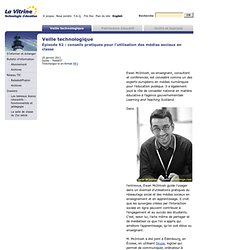
Il a également joué le rôle de conseiller national en matière éducative à l’agence gouvernementale Learning and Teaching Scotland. Dans l’entrevue, Ewan McIntosh guide l’usager dans un éventail d’utilisations pratiques du réseautage social et des médias sociaux en enseignement et en apprentissage. Il croit que les synergies créées par l’interaction sociale en ligne peuvent contribuer à l’engagement et au succès des étudiants. C’est, selon lui, l’acte même de partager et de médiatiser ce que l’on a appris qui améliore l’apprentissage, qu’on soit élève ou enseignant. M. Slideshare. L'ingénierie pédagogique: pour ... Instructional System Design. This short guide (less than a 10 minute read) provides a framework that is composed of four models: While you can click any part of the above map (to include the Complex/Complicated Environments) to learn more about the topic, it is suggested you read the following first to see how the various models tie together.

Instructional System Design — This guide to ISD uses the ADDIE model (analysis, design, develop, implement or delivery, & evaluation). It is perhaps the best know instructional design model and provides a solid framework for Learning or Instructional Designers. Note that ISD is considered a plug and play model in that it allows other model and frameworks to be plugged into it so that it can adapt to almost any learning situation or environment. While the model above shows that the ADDIE version of the ISD model is quite dynamic, the model below shows the various steps within each of the five phases:
Why Instructional System Design or ADDIE. Instructional System Design (ISD) is often referred to as ADDIE, which is the acronym for the five phases of ISD — Analysis, Design, Development, Implementation, and Evaluation.
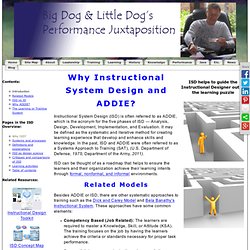
It may be defined as the systematic and iterative method for creating learning experience that develop and enhance skills and knowledge. In the past, ISD and ADDIE were often referred to as a Systems Approach to Training (SAT), (U.S. Department of Defense, 1975; Department of the Army, 2011). ISD can be thought of as a roadmap that helps to ensure the learners and their organization achieve their learning intents through formal, nonformal, and informal environments. Related Models Besides ADDIE or ISD, there are other systematic approaches to training such as the Dick and Carey Model and Bela Banathy's Instructional System. Competency Based (Job Related): The learners are required to master a Knowledge, Skill, or Attitude (KSA). Resources at GrayHarriman.com. Here you will find links to sites offering free online course.
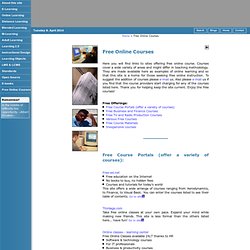
Courses cover a wide variety of areas and might differ in teaching methodology. They are made available here as examples of online learning and so that this site is a home for those seeking free online instruction. To suggest the addition of courses please e-mail us. Also please e-mail us if you find that the course providers start charging for any of the courses listed here. Thank you for helping keep the site current. Merrill on Instructional Design. E-Learning Resources at Gray Harriman.com. Learning Theories of Instructional Design. Instructional Design Models & Theories.
Instructional Design Models and Methods "Models, like myths and metaphors, help us to make sense of our world.

Whether derived from whim or from serious research, a model offers its user a means of comprehending an otherwise incomprehensible problem. An instructional design model gives structure and meaning to an I.D. problem, enabling the would-be designer to negotiate her design task with a semblance of conscious understanding. Models help us to visualize the problem, to break it down into discrete, manageable units. The value of a specific model is determined within the context of use. Extending Instructional System Design. The ADDIE version of ISD is probably the one basic tool that every Learning Designer needs to know and understand because: It is a good tool for getting new Learning Designers up and running No matter what planning and design tool you use to create your learning platforms, you will probably always fall back on some of the steps within ADDIE It keeps teams of designers in the loop by using a standard set of processes.

Instructional design models. Instructional design models offer users a way to comprehend a problem or situation with more ease.
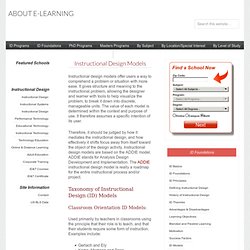
It gives structure and meaning to the instructional problem, allowing the designer and learner with tools to help visualize the problem, to break it down into discrete, manageable units. The value of each model is determined within the context and purpose of use. It therefore assumes a specific intention of its user. Therefore, it should be judged by how it mediates the instructional design, and how effectively it shifts focus away from itself toward the object of the design activity. Instructional System Design Concept Map. Click map area for more information on ISD, such as Learning Environment, Design, or Knowledge.
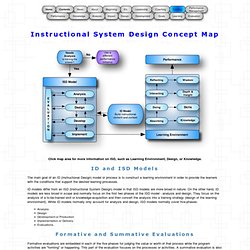
ID and ISD Models The main goal of an ID (Instructional Design) model or process is to construct a learning environment in order to provide the learners with the conditions that support the desired learning processes. Wimba 1: EDE overview & the ADDIE ISD Process. Wimba: 3 Implement - Evaluate. Wimba 1: EDE overview & the ADDIE ISD Process. Kevin Brake - Systematic Process to Instructional Design Part 3 of 3. Kevin Brake - Systematic Process to Instructional Design Part 2 of 3. Kevin Brake - Systematic Process to Instructional Design Part 1 of 3. The Assure Model Part 2. The ASSURE Model of Learning sample lesson. The Assure Model Part 3. The Assure Model Part 1. Instructional Design: Dick & Carey Model.
Instructional System Design (ISD) Handbook (ADDIE)